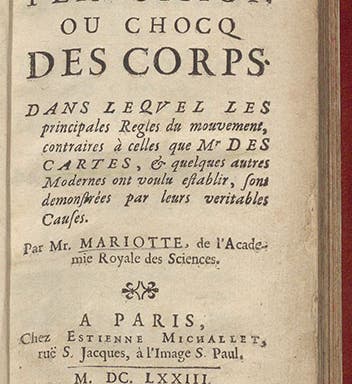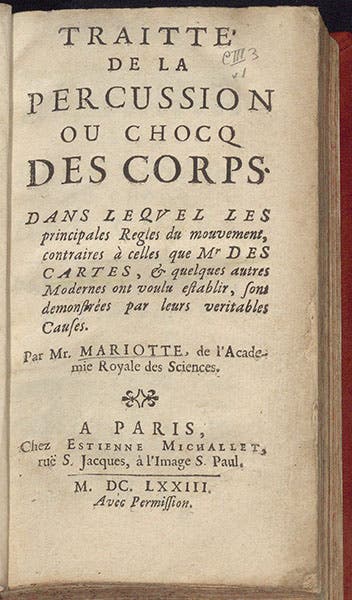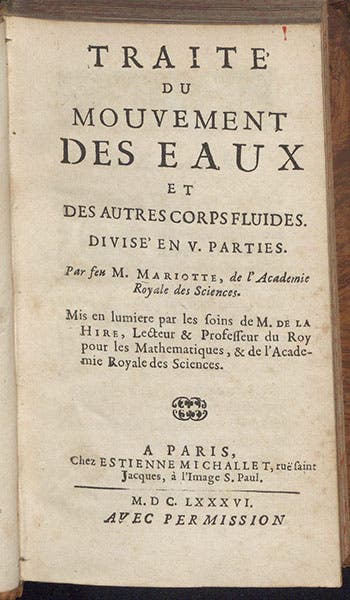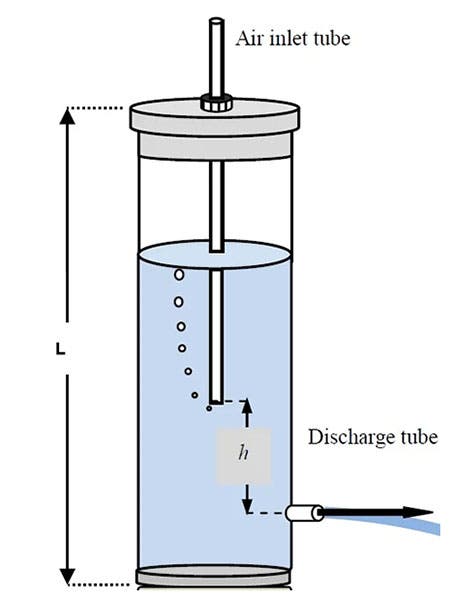Scientist of the Day - Edmé Mariotte
Edmé Mariotte, a French physicist, died May 12, 1684; we have no idea when or where he was born, or how old he was at his death. He just suddenly showed up in the historical record in 1668 as a member of the recently founded Royal Academy of Science in Paris. He made his initial mark with a theory that sap circulates in plants just like blood does in animals, and followed that with a bombshell discovery – the human eye has a blind spot! He demonstrated this by attaching two 9-inch-diameter paper spots to a wall, one about two feet to the right of the other, and a little below, and showing that when you cover your left eye, back up to about nine feet, and look at the left spot, the right spot suddenly disappears.
Mariotte’s most important work was in experimental mechanics. Whereas predecessors like Descartes had wondered what happens when a large object, moving at a certain speed, collides with a smaller object, moving at a different speed, and came to conclusions based on how nature ought to operate, Mariotte asked the same questions experimentally. He made pendulum bobs out of clay and let them collide, seeing how the degree of flattening varied with speed. He dropped ivory balls onto a steel anvil covered with talc, to see how the impact pattern varied with the height of fall (and demonstrating, in the process, that even a hard ivory ball is compressed on impact). In a eulogy published after his death, Mariotte was called “the man who introduced experimental physics to France.” Mariotte also did important work in pneumatics and hydraulics, discovering that when air is compressed, the volume decreases in proportion to the increase in pressure. English-speaking countries refer to this as ‘Boyle's law’; in France, it is known as 'Mariotte's law.' We have Mariotte’s Traité de la percussion ou choc des corps (Treatise on the Impact of Bodies, 1673) in our History of Science Collection, as well as his posthumous Traité de movement des eaux (Treatise on the Movement of Water, 1686), and several other of his works.
A little over two years ago, in a Scientist of the Day post on Leonhard Euler, we discussed a scientific toy called Euler’s Disk, and linked to this video. Mariotte also has a device named in his honor, called Mariotte’s bottle. I tried to buy one from a scientific toy company, but I couldn’t find one for sale – perhaps because they are so easy to make. I am afraid I did not think far enough in advance to make one for this post. The principle is simple. You take a plastic bottle with a tight-sealing cap, bore a hole in the cap and insert an open tube, like a heavy-duty straw, through the cap and down to about two inches from the bottom, then fill the bottle with water (third image, above). Where the tube goes through the cap has to be tightly sealed with glue or putty so there is no leakage of air. If you then bore or poke another small hole in the side of the bottle, about an inch below the open end of the tube, water will flow out through the hole. No surprise there. The surprise is that as the water level lowers inside the bottle, the amount of flow through the hole stays constant. If you were to do the same experiment without the tube, the water flow through the hole in the side would start strong and then weaken as the water level dropped. So Mariotte’s bottle is a constant-flow source of fluid. It works because the bottom of the tube is always at atmospheric pressure, so the head stays the same (the “h” in the diagram), and the fluid is always being pushed out with the same force. You can see a Mariotte bottle draining itself of fluid at a constant rate in this video; ten seconds will suffice. It is not nearly as dramatic as Euler’s disk.
There is a diagram of Mariotte’s bottle in his treatise on water, which I show here (fourth image, above). If you left the tube in the position shown in the diagram, no water at all would flow out of a hole at point C. But if you raise the tube to the level marked “L”, then there would be a positive head of pressure, and a constant flow from point C would ensue. Raise the tube higher, and the flow would increase in strength, but still remain constant.
Interestingly, the modern diagram above (third image), which I used because it is simple, came from a drip irrigation supply company, which sells the device to ensure a constant flow of water to drip irrigation systems.
But back to Mariotte the person. Mariotte is one of the most image-less important people in all of 17th-century science. If you search for “Edmé Mariotte” on Google Image, you will be offered portraits of Robert Boyle, Christiaan Huygens, Edmond Halley, and a few pseudo-Mariottes, but no real Mariotte. There is a well-known group portrait of the members of the French Academy being presented to King Louis XIV in 1667, made by Henri Testelin around 1675, which hangs in the palace at Versailles (fifth image, above), and it has been said (by a contributor to Wikipedia) that one of the figures at the left is Mariotte. Looking at a detail of the figures strung out at the left (sixth image, just above), we have been told that the 6th figure from the right could be Mariotte (or it might be Jean Picard), while the 3rd from the left could be Picard (or it might be Mariotte). We do recognize Huygens, the 7th from the right, and Giovanni Domenico Cassini, just to the left of Huygens). And the figure behind the globe at left (in the full painting) is supposed to be Gilles Personne de Roberval. But everyone else in the detail is up for grabs, meaning we just don’t know. Since Mariotte did not join the Academy until 1668, if the date for the gathering is correct, then he may not be in the picture at all. Or perhaps he is there, a little bit to the right of center, so that when you view the group portrait from the proper distance, his face falls right in our blind spot.
William B. Ashworth, Jr., Consultant for the History of Science, Linda Hall Library and Associate Professor emeritus, Department of History, University of Missouri-Kansas City. Comments or corrections are welcome; please direct to ashworthw@umkc.edu.








![Columbine, hand-colored woodcut, [Gart der Gesundheit], printed by Peter Schoeffer, Mainz, chap. 162, 1485 (Linda Hall Library)](https://assets-us-01.kc-usercontent.com:443/9dd25524-761a-000d-d79f-86a5086d4774/3829b99e-a030-4a36-8bdd-27295454c30c/gart1.jpg?w=210&h=210&auto=format&fit=crop)



